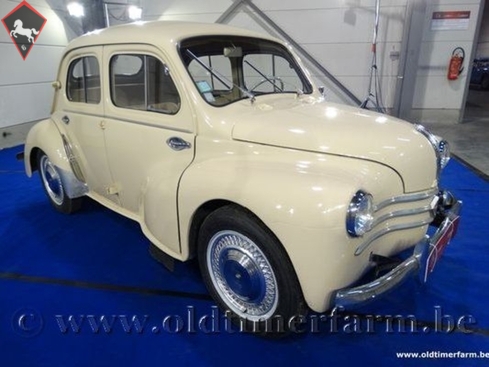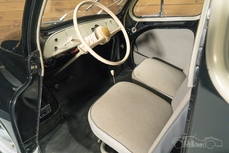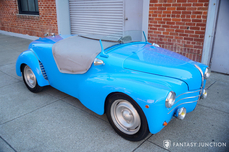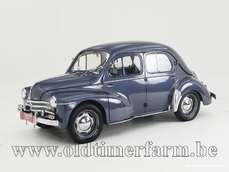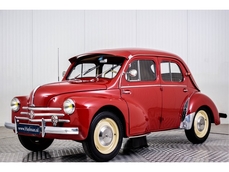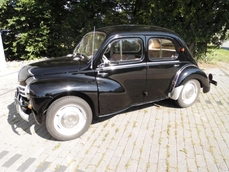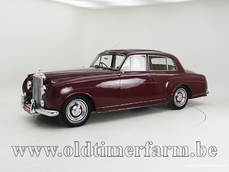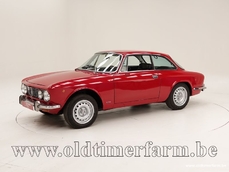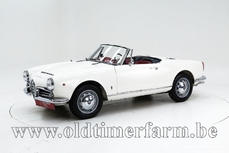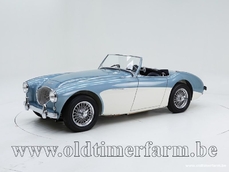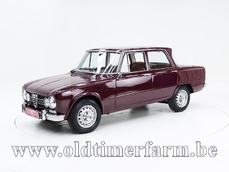Renault 4CV Beige '58 1958
Allgemeine Beschreibung :
(from Wikipedia, the free encyclopedia) The Renault 4CV (French pronunciation CAT shuVOH) is an economy car produced by the French manufacturer Renault from August 1947-July 1961. The first French car to sell over a million units, the 4CV was superseded by the Dauphine. The 4CV was a four-door sedan of monocoque construction, 3.6 m (11 ft 10 in) in length with front suicide doors[3] and using Renault's Ventoux engine in a rear-engine, rear-wheel drive layout. The car's name, 4CV, refers to the French abbreviation, CV, for the French equivalent to "horsepower" as a unit of power, translating from cheval vapeur." At the time, a vehicle's horsepower was used as its tax classification, which in the case of the 4CV was four taxable horsepower. In 1996, Renault presented a concept car the Renault Fiftie to celebrate the 50th anniversary of the 4CV's debut. It was a two-door, mid-engine design with styling similar to the 4CV. The 4CV was originally conceived and designed covertly by Renault engineers during the World War II German occupation of France, when the manufacturer was under strict orders to design and produce only commercial and military vehicles. Between 1941 and 1944 Renault was placed under the Technical Directorship of a francophile engineer called Wilhelm von Urach (between 1927 and 1940 employed by Daimler Benz) who took care to notice nothing of the small car project. A design team led by the company's Technical Director Fernand Picard, recently returned from Renault's aero-engine division to the auto business and Charles-Edmond Serre, who had been with Renault for longer than virtually anyone else envisioned a small, economical car suitable for the period of austerity which was expected to follow the war. This was in contrast to Louis Renault himself who in 1940 believed that after the war Renault would need to concentrate on its traditional mid-range cars. Jean-Auguste Riolfo, head of the test department, was made aware of the project from an early stage as were several other heads of department. In May 1941 Louis Renault himself burst into an office to find Serre and Picard studying a mock-up for the car's engine. By the end of an uncomfortable ad hoc meeting Renault's approval for the project, now accorded the code "106E", was provided. However, because the Germans had forbidden work on any new passenger car models, the 4CV development was defined, if at all, as a low priority spin-off from a project to develop a new engine for a post-war return of the company's 1930s small car, the Juvaquatre: departmental bosses installed by the Germans were definitely not to be trusted in respect of "Project 106E", while von Urach, their overlord, always managed to turn a blind eye to the whole business. The 4CV was ultimately presented to the public and media at the 1946 Paris Motor Show and went on sale a year later. Volume production was said to have commenced at the company's Billancourt plant a few weeks before the Paris Motor Show of October 1947, although the cars were in very short supply for the next year or so. Renault's advertising highlighted the hundreds of machine-tools installed and processes adopted for the assembly of the first high volume car to be produced since the war, boasting that the little car was now no longer a prototype but a reality. On the 4CV's launch, it was nicknamed "La motte de beurre" (the lump of butter); this was due to the combination of its shape and the fact that early deliveries all used surplus paint from the German Army vehicles of Rommel's Afrika Korps, which were a sand-yellow color. Later it was known affectionately as the "quatre pattes", "four paws".The 4CV was initially powered by a 760 cc rear-mounted four-cylinder engine coupled to a three-speed manual transmission. In 1950, the 760 cc unit was replaced by a 747 cc version of the "Ventoux" engine producing 17 hp (13 kW). Despite an initial period of uncertainty and poor sales due to the ravaged state of the French economy, the 4CV had sold 37,000 units by mid-1949 and was the most popular car in France. The car remained in production for more than another decade. Claimed power output increased subsequently to 21 hp (16 kW) as increased fuel octanes allowed for higher compression ratios, which along with the relatively low weight of the car (620 kg (1,400 lb)) enabled the manufacturers to report an 090 km/h (056 mph) time of 38 seconds and a top speed barely under 100 km/h (62 mph). The engine was notable also for its elasticity, the second and top gear both being usable for speeds between 5 and 100 km/h (3 and 62 mph); the absence of synchromesh on first gear would presumably have discouraged use of the bottom gear except when starting from rest. The 4CV's direct replacement was the Dauphine, launched in 1956, but the 4CV in fact remained in production until 1961. The 4CV was replaced by the Renault 4 which used the same engine as the 4CV and sold for a similar price. Specifications. Bodywork. Length/width/height/wheelbase cm (in) : 360/143/147/209 (142/56.3/57.9/82.5); weight : 560 kg (1235 lb). Mechanics. Engine straight-four 747 cc (45.5 ci), rear-mounted, 8 valves, 1 Solex carburettor, manual 3 speed gearbox, rear-wheel drive. Maximum power : 21 bhp at 4100 rpm; torque : 45 Nm at 2000 rpm. Top speed : 100 km/h (62 mph). This car is just in at Oldtimerfarm, Aalter Belgium. Steenweg op Deinze 51C. Teusday-Saterday 10-17h (no appointment needed) Sunday: closed. Monday strictly on appointment. We specialize in consignment sales of collection cars. We are proud we can offer this car for sale. A more detailed description will soon follow. In the meantime you can have a look at the very ample photo coverage on the website. Of course Xavier or Olivier will be very happy to give you all possible explanations by phone on +32472401338. Meet us at: Opendeurdagen Fri, September 18, 2015, 9am – Sun, September 20, 2015, 5pm
http://www.oldtimerfarm.be/en/collection-cars-for-sale/2151/renault-4cv-beige-58.php
1958 Renault 4CV Beige '58 is listed verkauft on ClassicDigest in Aalter by Oldtimerfarm Dealer for €7500.
Fakten der Auto
Karosserietyp : Auto Marke : Renault Modell : 4CV Ausführung : Beige '58 Hubraum : 0.0 Modelljahr : 1958 Lage : Aalter Fahrzeug Anmeldung : Normal
Verkauft
Angaben Zum Verkäufer
Verkauft
People who viewed this Renault 4CV also viewed similar Renault listed at ClassicDigest
Other cars listed for sale by this dealer
über Renault
Renault, ein Name, der so französisch ist wie ein Croissant und so tief in der Automobilgeschichte verwurzelt ist wie ein Baguette in einem Pariser Café. Lassen Sie uns eine gemütliche Fahrt durch die Annalen dieses traditionsreichen Herstellers unternehmen, sollen wir?Unsere Geschichte beginnt Ende des 19. Jahrhunderts, als die Brüder Renault, Louis, Marcel und Fernand, beschlossen, ihre erfinderischen Köpfe einzusetzen. Im Jahr 1898 stellten sie ihr allererstes Auto vor, den Renault Voiturette. Es war eine zierliche, heckgetriebene Apparatur, die wie etwas aussah, das Jules Verne entworfen haben könnte. Dieser winzige Vorreiter legte den Grundstein für Renaults Automobil-Erbe.
Nun, wenn wir über einflussreiche Renault-Modelle sprechen, dürfen wir den Renault 4 nicht übersehen. Eingeführt im Jahr 1961, war er die französische Antwort auf den Volkswagen Käfer. Der Renault 4 war praktisch, vielseitig und wurde entwickelt, um den Anforderungen des ländlichen Frankreichs gerecht zu werden. Er fühlte sich genauso wohl in der Stadt wie auf einem Bauernhof, eine wahre Verkörperung des französischen Pragmatismus.
Aber lassen Sie uns nicht den Renault 5 vergessen, oder "Le Supercinq", wie er in Frankreich genannt wurde. In den Mitte-70er Jahren eingeführt, war dieser kleine Kleinwagen eine Design-Sensation. Seine eigenwilligen, kantigen Linien und seine freche Persönlichkeit machten ihn sofort beliebt. Er war sparsam, Spaß zu fahren und wurde zu einem Symbol des französischen Stadtlebens.
Dann kam der Renault Espace im Jahr 1984. Er war einer der Vorreiter des MPV (Multi-Purpose Vehicle)-Segments. Der Espace war für Familien konzipiert, die die Praktikabilität eines Vans ohne den Komfort eines Autos wollten. Er markierte den Beginn einer neuen Ära im Bereich der Familienmobilität.
Und vergessen wir nicht den Renault Twingo, der 1992 eingeführt wurde. Er war ein kleiner Stadtwagen, der das traditionelle Konzept aufbrach, mit seinem innovativen Design und dem Heckmotor. Der Twingo war der Beweis, dass kleine Autos stilvoll und praktisch sein können, und er war ein Hit bei Stadtbewohnern in ganz Europa.
Nun, wenn wir über ein wahres Game-Changer sprechen wollen, dann ist es der Renault Clio. Erstmals im Jahr 1990 eingeführt, wurde der Clio zum europäischen Liebling. Er vereinte Stil, Leistung und Erschwinglichkeit auf eine Weise, die nur wenige Autos erreichen konnten. Er ist die Art von Auto, die sich sowohl auf den Champs-Élysées als auch in den engen Gassen eines französischen Dorfes wohl fühlt.
Aber natürlich dürfen wir den Renault Megane nicht vergessen. Seit seinem Debüt im Jahr 1995 ist er ein fester Bestandteil des Kompaktwagen-Segments. Mit seinem unverwechselbaren Heckdesign und einer Auswahl an Motoren für jeden Geschmack ist der Megane in einem hart umkämpften Markt weiterhin eine starke Konkurrenz.
Da haben Sie es, eine gemütliche Tour durch die Geschichte von Renault, einem Unternehmen, das immer einen Hauch von französischem Flair in die Welt des Automobils gebracht hat. Renault hat uns Autos geschenkt, die so vielfältig sind wie die französische Landschaft selbst, von praktischen Arbeitstieren bis hin zu stilvollen Stadtbewohnern. Es ist eine Marke, die genauso Teil des kulturellen Erbes Frankreichs ist wie eine Flasche Bordeaux oder eine Partie Boule. Vive la Renault
